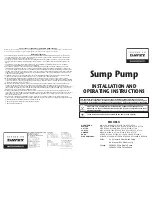
EN-6 452160.66.66 · FD 9508
www.dimplex.de
English
LIK 12TU
6 Set-UP
6.1 General Information
The device is designed to enable several connection options.
The position of the air outlet opening can be moved from right
(factory default) to left or top by turning over one of the two
screwed on covers.
The air-to-water heat pump must be installed in a frost-free, dry
room on an even, smooth and horizontal surface. Installation in
areas at risk from frost, e.g. in unheated technology buildings, is
possible if the control panel is mounted in the heated building
and the cables of the flow and return are routed in the building
with frost protection. The frame of the heat pump should lie di-
rectly on the floor to ensure an adequate soundproof seal. If sup-
porting feet are used, the heat pump must be installed horizon-
tally. In this case, the specified sound level can be up to 3 dB(A)
higher, and additional sound insulation measures may be neces-
sary.
The heat pump must be installed so that maintenance work can
be carried out without being hindered. This can be ensured by
maintaining a clearance of 1m in front of the heat pump and to
the side on which the heating water connections are located.
The side panel assemblies must not be covered by connecting
pipes.
Neither frost nor temperatures higher than 35 °C must occur in
the installation location at any time of the year.
Never install the device in rooms subject to high humidity. Con-
densation can form on the heat pump and air circuit if the humid-
ity exceeds 50 % and the external temperature is below 0 °C.
If the heat pump is installed on an upper storey, the load-bearing
capacity of the ceiling should be checked. On account of the
acoustics, measures for isolating possible vibrations should also
be very carefully planned in advance as well. Installation on a
wooden floor is not recommended.
6.2 Condensed Water Pipe
Condensed water that forms during operation must be drained
off frost-free. To ensure proper drainage, the heat pump must be
mounted horizontally. The condensate pipe must have a mini-
mum diameter of 50 mm and must be fed into a sewer in such a
way that it is safe from frost. Do not discharge the condensate di-
rectly into clearing tanks or cesspits, as aggressive vapours or a
condensed water pipe which has not been laid in a frost-free
manner could destroy the evaporator.
6.3 Sound
We recommend connecting the heat pump to the heating
system using a flexible hose to prevent solid-borne noise
transmission to the heating system if requirements regard-
ing noise are high.
Installed air ducts should be sound-isolated from the heat
pump to prevent the transmission of solid-borne sound to
the ducts.
If the transport restraint screws are not removed from the
compressor, acoustic emissions from the device are signifi-
cantly louder!
P
P
P
P
P
P
















































